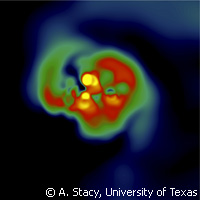The Universe's first stars: extraordinarily fast spinners
Astronomers using data from the Very Large Telescope (VLT) of the European Southern Observatory (ESO) have spotted the remains of some of the Universe's very first stars in the Milky Way. The gas cloud left behind when the stars exploded billions of years ago contains elements in proportions different to those found in new stars, shedding light on the 'missing links' between the Big Bang and today's Universe. Even with the most powerful telescopes, it is not possible to observe these stars directly. They are so old that only the most massive, with eight times or more the mass of our sun, would have had the time to die and pollute the gas from which they were formed with elements heavier than helium. These stars lived fast and died young, after no more than 30 million years. 'We think that the first generations of massive stars were very fast rotators - that's why we called them spinstars', explains Cristina Chiappini from the Leibniz Institute for Astrophysics Potsdam (AIP) in Germany and the Istituto Nazionale di Astrofisica (INAF) in Italy, who led the study published in the journal Nature. Dr Chiappini and her colleagues have found the remains of these stars in the oldest known globular cluster in our Galaxy, the 12-billion-year-old NGC 6522 which probably witnessed the early phases of the seeding of heavy elements across the Universe. Professor Georges Meynet, from the University of Geneva in Switzerland, explains that it is like trying 'to reveal the character of a cook from the taste of his dishes'. The researchers discovered eight old stars with strangely high levels of the rare elements strontium and yttrium. They also calculated that the stars would have whirled with a surface speed of 1.8 million kilometres per hour. By comparison, massive stars in the Milky Way typically spin at about 360,000 kilometres per hour. This high rate of spin would cause overlap between inner and outer gas layers of the stars that would not otherwise mix. The resulting cascade of nuclear reactions would generate radioactive neon, which in turn would emit neutrons that would collide with iron and other heavy atoms to create strontium and yttrium. After the spinstars' death, these elements made their way into new star-forming clouds and eventually into the stars of NGC 6522. These findings suggest that these fast spinners may have changed the face of the Universe in dramatic ways. For instance, their fast spinning could have led them to create and disperse heavy elements across the Universe much earlier than previously thought. It could also have led to a greater-than-expected number of gamma ray bursts, the most powerful explosions known in the Universe. However, 'alternative scenarios cannot yet be discarded, but we show that if the first generations of massive stars were spinstars, this would offer a very elegant explanation to this puzzle!', says Cristina Chiappini. Therefore, Urs Frischknecht, a PhD student at the University of Basel in Switzerland, is currently working on further testing the proposed scenario.For more information, please visit: Leibniz Institute for Astrophysics Potsdam: http://www.aip.de/en Nature: http://www.nature.com/nature/index.html
Countries
Brazil, Switzerland, Germany, Italy, Japan, United Kingdom



